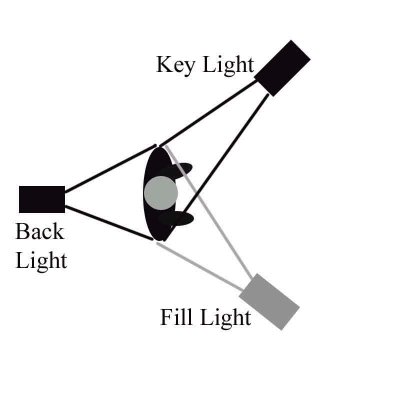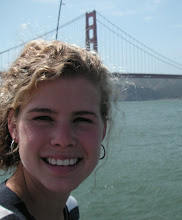This print was taken using three point lighting set up at school with the professional lights. We were just experimenting, yet some of the images came out with the proper hard lighting effect (distinct shadows on the facial features). It's called SPAIN because the girl had SPAIN written on her Tshirt, which I cropped out of the final print.
Test strip 1
aperture: 5.6
time: 10

The test strip shows a grayish uniformity. This means that not only are the settings wrong, also the strip was not left in the developer long enough to make the dark parts rich enough. At this stage, the image still looks like a painting portrait, not a photography portrait.
Test strip 2
aperture: 5.6
filter: 3.5
time: 20/25/30

Next I added in a filter to try to remove this gray color, as it was making it look like there was a fog in front of the girl's face. The filter worked, as now we see a great contrast between her dark hair and the white skin, as well as detail in the eye area. The section of the test stip at 20 seconds is too pale, which makes her look sick. The time at 30 seconds is quite dark, although we can only see the wall, even that is too dark to see the crumbly texture of the wall. The middle section, at 25 seconds, however, is just right. There is shading around the nose area, and the eyes, but the lighter parts are not so light that it looks too unnatural. Also, you at 25 seconds, you can still distinguish the face from the wall behind.
Final Print
Camera: Nikon N60
Lens: 75-300mm
Aperture: 5.6
Filter: 3.5
Time: 25 seconds

The final print turned out well to demonstrate the effects of hard light. While the composition may be quite basic, it gets the point across about how hard lighting makes a face look. There is shadowing on the whole left side of the face, and each contour around the eyes and nose has a shadow. Another nice detain about hard light is that this shadowing takes place other places, like on the wall behind, and just beside the collar to make it look textured and grainy.
Print 2: Beginner's Confusion [Portrait: Soft Lighting]
This print was a second try. First I printed a full print of the same subjects, and it turned out that the print used primarily hard lighting. I've included the first version full print as a test strip, as I worked off of the settings of aperture, time, and filter that worked for the first try to see if they worked for the second.
Test strip 1, 2
1st:
aperture: 5.6
time: 8, 10, 12
2nd:
aperture: 5.6
filter: 5
time: 25/30/35


The first and second test strips show no range of shades. They are too dark and too gray. Even adding a filter 5 for the second test strip did not alter the contrast at all. So I decided to close the aperture.
Test strip 3
aperture: 11
filter: 3.5
time: 55,60,65

This helped some, but still, the faces are just one shade. The background is fine, but there is no level of detail on the faces of the subjects themselves. At this point I realized the trick of exposing the test strip for less time, and then placing it in the developer for longer, as if to give the dark shades more of a chance to show without exposing the light shades for more time. Hard to explain, but with the paper we were using, it worked for me.
Test strip 4
aperture: 11
filter: 3.5
time: 23 (note: left in developer longer)

Although at this point I realized that the print was hardly lit, I used about the same settings for the final print of the correct lighting situation.
Final Print
aperture: 11
filter: 3.5
time: 14

The final worked out nicely. The soft lighting is more obvious on Alex, yet both of them seem to glow a bit as the soft lighting from all sides is flattering to their faces, contrary to hard lighting. Here, soft lighting evens out the skin tone, and makes it smooth, while hard lighting caught all the textures and shapes on the face and made them noticable.
Print 3: Getaway Boat [Landscape: Hard Lighting]
Test strip 1,2,3
1st- aperture: 5.6, time:10,12,14,16
2nd- aperture: 8, time: 10, 12, 14
3rd- aperture: 11, time: 8,10,12

I tried each of these apertures to determine which was the best, looking mainly at the boat. At 5.6, the boat was dark, like its surroundings, so it blended in so much that it was almost lost. At 11, the boat was too pale and washed out. This was solved by going in the middle, at 8. Still, the print is not dark enough. So for the final print, I lowered the time and left it in the developer.
Final Print
aperture: 8
time: 8

The final print of the landscape image turned out better. The boat is distinguishable from its surroundings. Also there is contrast between the canal water and where the light reflects off of it. I like this lens, because it lets me zoom in on certain things more accurately that are far away, like this boat was, and frame them into a finished product like this.
Print 4: Bridge to [Landscape: Soft Lighting]
This image is a landscape photo using soft lighting. In places, the sun shines through the trees and hits something as hard lighting, such as the top of the bridge, but for the most part, the heavy trees mute the light so it shines softly and evenly.
Test Strip 1
aperture: 8
time: 7,8,9,10

This test strip is too faded. A good start, and the contrast looks like it will be okay, but at these settings, too bleached and washed out. For example, looking down the path into the light area: it fades into the grey circle around it, when I want it to be a light patch in a darker surrounding.
Test Strip 2
aperture: 8
time: 10

So I tried the whole thing at 10 seconds. This time it came out much better, as a shadowy image with a few light splotches, as it was when I took the photo.
Final Print
aperture: 8
time: 10

This final turned out well, as a softly lit shadowy scene featuring several lighter bits, where the light shines in from the trees and leaves circles on the ground, and the light coming from behind the bikers down along the path, which gives this part of the image and eerie look. I also like the perspective of looking down the path into the light at the end, like a tunnel of trees.
Print 5: Great Grandmother's Perfumes [Still Life: Hard Lighting]
This print is my favorite of the project. It was taken of my mom's makeup desk when the light was coming in the window strong and nearly horizontal.
Test Strip 1
aperture: 5.6
time: 8,10,12

This test strip shows a lack of contrast. There appears to be a fog in front of everthing. Even so, you can still see the shine of the caps of perfume bottles, so I could tell it would turn out nicely with more contrast. To get this, I closed the aperture.
Test Strip 2
aperture: 11
time: 18, 20, 22

This time there is more contrast. Although there is still too much gray, the bottles start to separate from each other and more detail is visible, for example the pattern on the picture frame behind the bottles. The problem now is that the time is too high and the time in the developer too low.
Final Print
aperture: 11
time: 14

Now the image shows proper contrast and proper shading. The darks are dark enough, so that they have rich color and the light coming in from the side creates bleached areas. For example, the container at the far left, on the left hand side of it, detail can be seen, but on the right, the pattern is lost to a bleached out area where light hits. The effect of the light streaming in from the side is to make the glasses look as thought they are glimmering, where enough detail is shown to make it interesting, but enough detail lost in some places to make it whimsical, even unclear. It looks like an antique, and the unconventional way that light illuminates and cast shadows makes it look even more from the past.
Print 6: Flower Pots [Still Life: Soft Lighting]
Test Strip 1
aperture: 5.6
time: 16,18

The first test strip shows okay contrast. There is some detail in the leaves between the green part and the lighter green veins. However, once you see below this, there is simply a dark region. the difference between the irn in front and the one behind, and between the one behind and the background is almost nonexistent.
Test Strip 2
aperture: 5.6
time: 6,7,8

So I tried lowering the time and leaving it longer in the developer. This helped to make the dark colors richer, and also provided more detail in the leaves, but did nothing to help set the irns and the background apart from each other.
Final Print
aperture: 8
time: 9

So for the final print, I chose the close the aperture to 8 and expose for 9 seconds. This solved the problem and the final print shows more clarity between the fore and background. Also, closing the aperture allowed for more detail in the irns themselves; now you can see the ridges and the design in the stone.









